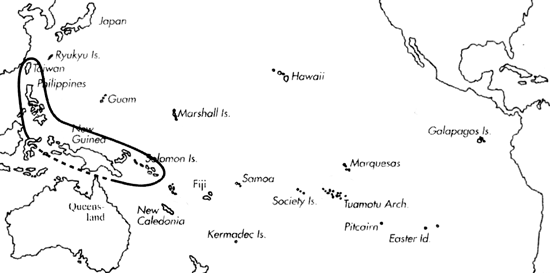Range: Typical form: Philippines to Melanesia (Papua New Guinea, Solomon Is.); W. Thailand. Form blatteus: Taiwan to Philippines.
Description: Moderately small to medium-sized, light. Last whorl narrowly conoid-cylindrical to narrowly ovate, narrowly cylindrical or narrowly conical; outline mostly straight with nearly parallel sides adapically, variably concave to straight (left side) or straight to slightly convex below (right side). Shoulder subangulate to rounded. Spire of moderate height; outline of teleoconch spire whorls domed. Larval shell projecting, of about 3 whorls; maximum diameter 0.8-0.9 mm. First 1-3.5 postnuclear whorls weakly tuberculate. Early teleoconch sutural ramps flat, with 1-2 increasing to 4-5 spiral grooves; late ramps flat to slightly convex, steeper and stepped, with spiral striae; last ramp may be slightly concave. Last whorl with a few weak to obsolete spiral ribs at base. Form blatteus of similar size. Last whorl similar in shape and outline, may be broader. Spire sometimes higher, outline convex to domed. Larval shell projecting, of 3-3.75 whorls; maximum diameter 1- 1.1 mm. First 0.5- 1.25 postnuclear whorls weakly tuberculate. Teleoconch sutural ramps flat to slightly convex, with 2 increasing to 4-9 spiral grooves; latest ramps steep and strongly stepped in large specimens. Last whorl with weak spiral ribs at base grading to variably spaced threads above.
| Shell Morphometry | ||
|---|---|---|
| L | - | |
| RW | - | |
| RD | - | |
| PMD | - | |
| RSH | - | |
Typical form: Ground colour grey, violet or pinkish to purplish red. Last whorl with reddish brown axial clouds and blotches forming 2-3 spiral bands within basal third, near centre, and sometimes just below shoulder. Dotted or dashed brown spiral lines from base to shoulder, often reduced. Larval whorls and adjacent 0.5-2.5 sutural ramps orangish to purple red. Following sutural ramps with scattered brown radial streaks and blotches with spots at inner margins. Aperture matching last whorl in colour. Form blatteus: Ground colour reddish purple. Last whorl with 3 spiral rows of brown blotches, below shoulder, at centre and within basal third. Dotted to dashed brown spiral lines from base to shoulder, often reduced. Larval shell pale yellow to beige. Postnuclear sutural ramps grading from grey to purple, maculated with reddish brown radial blotches. Aperture matching last whorl in colour.
Periostracum thin, translucent, smooth.
In typical form, dorsum of foot white, grading to pink at anterior end, spotted with cream medially. Sole of foot cream. Rostrum and tentacles white. Siphon mottled orange and red, paler proximally (Chaberman, pers. comm., 1981)(Pl. 82, Fourth row, right).
Habitat and Habits: In 20-240 m, associated with corals and in coral rubble.
Discussion: A number of similar and sympatric species are often confused with C. viola. For the distinctions from C. austroviola and C. corallinus, see the Discussions of those species. C. luteus has a more conical last whorl (PMD 0.76-0.94) and a white aperture; its late sutural ramps are not stepped and steep. C. blatteus is tentatively assigned to C. viola, because we have only seen a few specimens from Taiwan and Philippines corresponding with the holotype from off Taiwan (Pl. 49, Fig. 12). They do not allow unequivocal separation at species level.

C. viola range map
This section contains verbatim reproductions of the accounts of 316 species of Conus from the Indo-Pacific region, from Manual of the Living Conidae, by Röckel, Korn and Kohn (1995). They are reproduced with the kind permission of the present publisher, Conchbooks.
All plates and figures referred to in the text are also in Röckel, Korn & Kohn, 1995. Manual of the Living Conidae Vol. 1: Indo-Pacific Region.
The range maps have been modified so that each species account has it own map, rather than one map that showed the ranges of several species in the original work. This was necessary because each species account is on a separate page on the website and not confined to the order of accounts in the book.